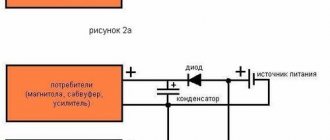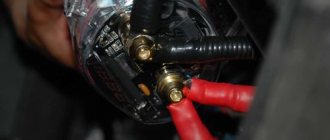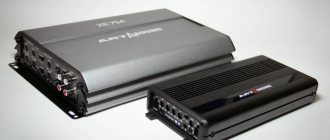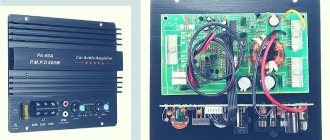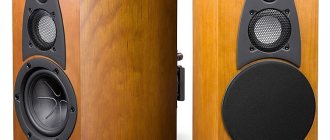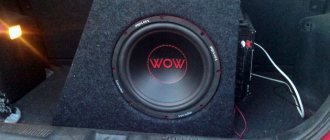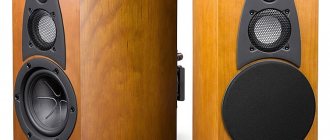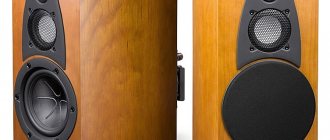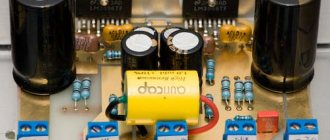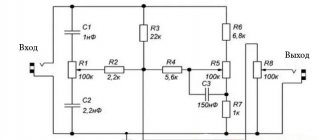This question is asked very often, and here I came across a very competent explanation from Evgeniy Mitskevich.
How to choose amplifier power for a subwoofer?
You have decided on a speaker for the subwoofer, and next is the task of choosing an amplifier. Searching the Internet for an answer can be confusing for anyone. The breakdown of opinions is something like this:
— The amplifier should be less powerful than the subwoofer. To avoid overloading the speaker. — The power of the amplifier must be equal to the power of the subwoofer. — The amplifier must be more powerful than the speaker for the subwoofer.
Swan, crayfish and pike, in a word... Moreover, they don’t say how much more or less the power of the amplifier should be.
Let's try to figure out who is right and who is wrong.
First let's agree that:
— We have decided on the nominal impedance of the speaker. That is, we connected the sections of the voice coil the way we needed and got the required resistance. — The amplifier must be able to handle such a load. — By “power” we mean rated power. This is normalized for both the speaker and the amplifier. It is called RMS - root mean square.
For a speaker, this is the power that it can withstand for a long time without irreversible changes in its parameters. There are still some reservations in the standards, but we are not focusing on them for now.
For an amplifier, this is the maximum power at which its distortion does not exceed a certain value. There are also nuances, but in this case they are unimportant.
And here's something else we need to keep in mind. The speaker can be damaged either by mechanical stress, thermal damage, or both.
Mechanical is when the moving system of the speaker is destroyed due to a significant excess of the maximum cone stroke. A slight excess, up to 20%, is usually acceptable.
Thermal – when the voice coil overheats for one reason or another.
What are these reasons?
The first cause of thermal damage is amplifier clipping. This happens all the time if the amplifier power is insufficient. You turn up the volume, and the amplifier has exhausted its undistorted amplification capabilities and begins to produce a lot of harmonics. That is, it sends a bunch of different frequencies to the speaker, higher than the main one. The voice coil quickly heats up and burns out if you do not turn down the volume in time.
The second reason for thermal destruction is the exit of the voice coil beyond the working gap of the magnetic system. While it moves within the working gap, its turns are in a magnetic field, and the energy of the current flowing through them is spent on the movement of the cone. And when the turns of the voice coil leave the working gap, all the energy of the amplifier carried by the current goes to heating the coil. In this case, heating occurs more slowly than in the first case, but only slightly. We gape - and goodbye, speaker! See you after the renovation!
Mechanical damage to the movement often occurs with a short-term strong signal. The impact of the drum, the clap of the transient of the amplifier or head unit, are the main reasons for the “spitting out” of the cone. This happens especially often in so-called “open” designs (phase inverter, HF resonator), if a subsonic filter is not used.
Another reason for exceeding the maximum stroke is playing tracks that contain too low frequencies. At these frequencies, the movement of the cone increases greatly, and the movement can be destroyed even by a signal of relatively low power, much less than the nominal one.
So what about the amplifier? And so bad, and so bad...
Without claiming to be the ultimate truth, I will give my thoughts.
A weak amplifier is bad. Unconditionally. Definitely. No options. The risk of burning the voice coil is too great.
The power of the amplifier is equal to the power of the speaker - also not very good. Why? Because the rated power of a car amplifier is usually standardized for a supply voltage of 14.4 Volts. But in real conditions, we would never maintain such a voltage at the amplifier terminals. It will fluctuate during the game anyway. And if we also connect the headlights, stove, brushes... In a word, the amplifier will go into the clip without reaching its rated power. The voice coil is also at risk of overheating.
And finally, the third option: the amplifier is more powerful than the speaker. In my experience, it is optimal when the amplifier power is 1.5-2 times higher than the rated power of the subwoofer. A legitimate question arises: what about mechanical damage? Answer: yes, it can happen. But if you don’t abuse the speaker by constantly pushing it to maximum speed and abusing “infra-low” tracks, then it will live happily ever after.
As you can see, there is no 100% way not to kill the speaker. Therefore, we keep our head on our shoulders with any amplifier.
The third option, when the amplifier is more powerful, gives the speaker a better chance of long life. I suggest you stop your choice on it.
Hi all. Today we will try to analyze the reasons why subwoofers and other speakers burn out, break, or fail.
In general, if the components are of high quality, used in proper conditions and correctly selected for the system, then they will delight the owner with a pleasant sound for a very long time. Unfortunately, many possible errors can lead to a sharp reduction in the life of speakers and amplifiers. Let's talk about the most common ones.
Problems in installation
Careless installation is one of the most common causes of breakdowns. Correctly performed installation is the key not only to vehicle safety and sound quality, but also to the safety of components. When installing the system, you need to take into account many important points: how and where to correctly position the amplifiers, how to connect the amplifier and correctly position the power wiring in the cabin, how to correctly connect the subwoofer and what resistance to choose for the coils, etc. Some errors can degrade the sound, some can damage components, and some can cause fires . Therefore, be very careful about installation.
Of course, to get good sound, you need to choose reliable components. For example, low-quality amplifiers may have very low overload protection, which causes widespread popping and clicking of the subwoofer (speakers) when the radio is turned on or off (you can find out how to deal with this in the article “Why does the subwoofer pop”), this is not pleasant to the ear and is harmful for the subwoofer, but to get to the bottom of the truth you will have to work hard.
The best subwoofer for home theater - choosing top models
The price range of top-end subwoofers for home theaters starts from 50 thousand rubles.
- JBL PRX 718 XLF
This is a heavy-duty speaker system with an average cost of 112 thousand rubles. Weight up to 40 kg. Amplifier power 1500 W! The sound pressure value is within 134 dts. Reproduces frequencies from 30 to 130 Hz, which is quite enough for a concert hall.
- JBL Studio 650P _
JBL Studio 650P is the best addition to any home theater. The average cost of the device is 60 thousand rubles. The subwoofer will create surround sound in any room, because its rated power is 250 W. Column weight – 23 kg. It features a stylish design and high-quality reliable components.
- DALI SUB E-12 F
The average cost of a low-frequency acoustic system is 50 thousand rubles.
Bass reflex subwoofer. Maximum amplifier power – 220 W, nominal – 170. Frequency range 29 – 190 Hz. Perfect for a room up to 40 sq.m.
How to choose a subwoofer for a home theater and which is better, bass reflex or in a closed box:
Incorrect amplifier setting
Standard amplifier setup (monoblock)
Errors when setting gain, incorrect use of filters, incorrect use of bass boost - all this contributes to the failure of the speaker. You need to choose the right sound range, trim infrasound, cut off unnecessary frequencies, use bass boost wisely and set the gain correctly, then your components will not be threatened by the amplifier settings. How to properly configure the amplifier, read the corresponding article.
Improvers
All literate people and correct lessons say that the improvers on the radio (extra bass, loud, equalizer, etc.) do not need to be touched. A natural question arises: “What are they even needed for?” It's simple - they provide the opportunity for individualization - choosing the nature of the sound to suit your tastes; create the misleading impression that the system can play any music; hide the obvious shortcomings of weak components on the stock.
I'm talking about standard ones, because in independent systems, components are selected for a certain musical direction, the design of the acoustics is created and the subwoofer settings are determined, and the equalizer is used to equalize the amplitude-frequency characteristics of the sound. Experienced people use an equalizer , because with such settings the risk is not always justified and you need to understand all the processes well.
Therefore, often turned on super-bass and a cranked-up equalizer, coupled with an unsuitable amplifier or weak wiring, send the speakers for repair.
Very powerful amplifier
Oddly enough, but for this reason components come out very rarely; usually the opposite happens. A person wants louder music, buys more powerful speakers instead of standard ones, they burn out, he thinks that they were weak and he needs even more powerful ones - the picture repeats itself. The result is a car enthusiast who is furious, deeply misled and confused. The same thing often happens with weak amplifiers and subwoofers (how to choose the right subwoofer-amplifier pair).
In the case of amplifiers with excess power in relation to the speakers, the latter fail mainly due to incorrect matching of signal levels . Simply put, the gain is not set correctly.
If you have already read from the link in the previous paragraph about the correct selection of an amplifier, then you know that the amplifier should always be more powerful than the subwoofer and double the excess is the ideal option. In principle, such an amplifier can be called too powerful. However, if the gain is set correctly, it will be completely safe (you can learn how to correctly set the sensitivity or gain in the material “How to set up an amplifier”). In addition, this combination is very reliable and has the best sound quality. A powerful amplifier with properly limited sensitivity is always stable , does not distort at any peaks, and therefore you don’t have to worry about clipping. All this fully applies not only to subwoofers, but also to acoustics.
Happy using!
How to make a subwoofer for a home theater with your own hands
If you need a powerful subwoofer for your home theater, but you don’t have enough money to purchase it, you can make the equipment yourself. For a homemade device you will need:
- a regular speaker (let’s take a 10-inch “Pioneer” speaker, model TS-W255C; average cost: 800 rubles);
- power supply, for example, from an old PC (500 W);
- car amplifier with built-in crossover (Lanzar Heritage);
- inexpensive car subwoofer;
- columns;
- speaker wires;
- Fiberboard for the frame (recommended width - 18 mm);
- paint, primer.
Let's get to work.
- We start with the design of the body . For this purpose, we will use 3D visualization software – Sketchup. Dimensions are calculated using WinISD. The result was a cube-shaped body. The height of each side is 35 cm. The port is designed at the bottom, while the permissible output power is 32 Hz.
- At the next stage, we cut out the frame from fiberboard.
The fuse can be made from neoplene, which is very inexpensive. - The third step is to make a port. A plastic gutter 110 mm wide suited us perfectly for this purpose.
- Next, we assemble and glue the frame using high-quality wood glue.
- Using glue and silicone sealant, we mount the previously assembled port into the frame.
- We cut and sand the holes.
- We prime the body in several layers. And we paint it with car paint.
- Let's move on to working with the inside of the case. We take the insulation and, using a construction stapler, fasten the material to the walls of the frame. This way we avoid excessive noise when sounding.
- The next final stage is to install the power supply, grounding wires, and amplifier.
The result is a very decent subwoofer for little money. The cost of the device is about 2.5 thousand rubles.
How to choose an amplifier for a subwoofer based on power
If for an acoustic amplifier the main attention should be paid to sound quality, then in the case of a subwoofer the key characteristic when choosing is power. It comes in two types:
- Maximum (PMPO). As a rule, it is indicated on the housing and means the total power for all channels with distortion. You should not rely on this indicator, since it does not correspond to reality and serves only as a bait for the buyer.
- Nominal (RMS). Usually recorded in the data sheet or indicated on the box. Rated power is the very figure that should be used as a guide when making a purchase. The parameter should be specified at a THD of less than 0.1% and a voltage of 14.4 V.
Good amplifiers for subwoofers are equipped with a certificate that contains information about the product serial number and the actual power indicator obtained under factory measurement conditions. Such data is traditionally provided by serious companies like Rockford Fosgate, Alpine or MTX.
It is a well-known habit of the majority of companies to slightly inflate the power value in order to attract the attention of a potential client. Against this background, the DLS brand stands out favorably: the manufacturer deliberately slightly underestimates the real figure, moving into a lower category of devices, where it easily maintains leadership.
There is endless debate about what the amplifier power value for a subwoofer should be. There are only three points of view:
- It is necessary that the amplifier be less powerful compared to the subwoofer. This opinion is erroneous, since a weak device will cause the voice coil to burn out.
- Preference should be given to an amplifier that is equal in power to the subwoofer. In this case, there is also a catch - the rated power is normalized for a voltage of 14.4 V, which is almost never maintained at the amplifier outputs. This situation is fraught with overheating of the voice coil.
- It is better that the amplifier exceeds the subwoofer in power. The best option from a security point of view for equipment. The only risk is the possibility of mechanical damage to the coil, but this can be avoided by not turning the speaker to maximum and not listening to ultra-low frequency tracks too often.
Since the superiority of an amplifier over a subwoofer in terms of power gives the greatest chance of a long period of useful operation of the devices, it is recommended to prefer this option. Also, there is ongoing debate on the Internet about the required number of watts. As practice shows, it is better to choose an amplifier model 1.5-2 times more powerful than a subwoofer.
Minimum Required
The number of subwoofer offers on the Hi-Fi market is very large, but in order to find among them exactly the one that is suitable for your system and the room where it is installed, you need to take into account some circumstances.
In order for a pair of speakers and a subwoofer - such a set is called a triphonic - to form a single acoustic whole, their radiation must be carefully coordinated. Since stereo amplifiers, as a rule, do not have a crossover function, that is, dividing the signal into frequency bands, the subwoofer must have one. And it really is available in almost all models that are not included in “one box” speaker sets for a home theater or with a sound bar, but are sold as an independent component. Active subwoofers also have volume control. Many have a switch that allows you to rotate the signal phase 180 degrees.
Amplifier for subwoofer: which one to choose? Technical specifications
For an amplifier, only the power indicator is critically important; the remaining characteristics can be looked at in so many ways. But you should still pay attention to the following parameters:
- Frequency range. The user needs to ensure that the spread is not too large. Serious companies give the most specific values - for example, from 15 to 350 Hz. If the range is specified within 10-500 Hz, then most likely this is just a marketing trick, and the amplifier will not work well at the stated frequencies.
- Amplifier class. He can be:
- AB is an analog device with good amplification quality, but low efficiency and the same power;
- D is a powerful digital amplifier that demonstrates high efficiency, but has poor performance.
- Number of channels. According to this criterion, devices are divided into the following groups:
- single-channel (monoblocks) - designed for low-resistance loads within 1-2 ohms. They are rare, mainly in professional car audio systems, where the output power is much more important than the sound quality. They almost always belong to class D. Good examples are DLS XM10, Alpine PDX-M6, DLS MAD15;
- two-channel - designed for subwoofers designed for 4-8 ohms. They can be connected via a bridge circuit or via a subwoofer/coil if there is sufficient power. The following models have proven themselves well - Eton SR 100.2, Genesis Profile Two, DLS MA23;
- three-channel - practically never found, as they are replaced by 4-channel amplifiers;
- four-channel – are the most popular. Such devices can be used for 4 speakers, a subwoofer and a pair of speakers, as well as 2 subwoofers. Due to their versatility and ease of installation, 4-channel amplifiers are recommended in most cases. For example, you can choose one of the following models - Focal FPP 4100, Alpine PMX-F640, Eton SR 60.4, DLS XM40;
- five-channel - are four-channel amplifiers with an additional subwoofer channel, thanks to which you can also connect front and rear speakers. These models allow you to save space and also spend much less money than if the amplifiers for the subwoofer and speakers were installed separately. It is worth paying attention to such devices – Audison SR 5, DLS MA51, Alpine PDX-V9;
- six-channel - almost never used, since a rare car audio system requires such amplifiers. But there are still 6-channel models on the market, for example, Gladen XS 75c6 and Mosconi Gladen One 60.6.
Technical characteristics worth paying attention to
When choosing a subwoofer, we pay attention to the fundamental technical characteristics of the device:
- One of the most important is the frequency range . The output power is conventionally divided into several octaves, namely deep bass (20 - 40 Hz), mid (40 - 80 Hz) and high (80 - 160 Hz). Moreover, the range of most models is 40 – 200 Hz. Frequencies from 5 Hz are reproduced only by a few models.
- The next parameter is maximum sound pressure , in other words, the maximum volume of the subwoofer.
Interesting to know. The lowest level perceived by humans is called the hearing threshold. Its value is 0 dB. The highest is the pain threshold - 120 dB.
- The sensitivity of a woofer is the ratio of average sound pressure to 1 W of power and a distance of 1 m. Generally, the higher the sensitivity (dB), the better the sound of the speaker system.
- Crossover frequency . Here we understand the frequency at which the signals are separated. For example, if the crossover frequency is 90 Hz, then all components of the signal with a frequency range of 20 - 90 Hz will be sent to the subwoofer, while the signal with frequencies above the specified value will be sent to the main speaker systems.
- Subwoofer diameter The design of the subwoofer cabinet also greatly determines the acoustic properties of the device. There are 3 main types of design for the dynamic low-frequency head of a subwoofer - bandpass, closed and bass reflex. Each type has its own advantages and some disadvantages.
Bass reflex sub
Power
Which amplifier is best for a subwoofer? In order to choose the right amplifier, you first need to get acquainted with the three most common opinions:
- The power of the selected device should be less than the power of the subwoofer to avoid overloading the speaker.
- The powers must be equal.
- The amplification device must have high power.
Where is the truth? Let's understand a little bit.
The amplifier is weaker than the subwoofer
When choosing a resistance value, you need to understand that the amplifier must operate at such a load; now you can take on the power. We need to know the value of the rated power. The speaker should work stably at such values without disastrous consequences. For an amplifier, this is the maximum power at which the distortion level is acceptable.
There are nuances for both the speaker and the amplifier. The speaker can be damaged by mechanical or thermal effects, if not both. Mechanical impact causes the moving system to fail. In order to avoid this, you need to correctly select the maximum cone stroke values. It should not exceed twenty percent.
Thermal effects manifest themselves as overheating of the system, which can occur for the following reasons:
- Amplifier clipping. The reason for this problem is the lack of device power. In other words, you turn up the volume, and the amp begins to choke and produce harmonics, sending a lot of high frequencies to the speaker. The voice coil will overheat very quickly and burn out if you don't turn down the volume.
- The movement of the coil outside the working gap of the magnetic system. If the turns of this coil leave the working gap, all the energy of the device will be spent on heating the coil. Of course, it will reach overheating more slowly, but you may not be able to keep track of it if you lose the speaker.
Important! It is advisable not to listen to tracks with very low frequencies. It is at these frequencies that movement can be destroyed by a signal of even low power, even if significantly less than the nominal one.
Don’t think that selecting an amplifier for a subwoofer will reach a dead end now. The main thing in this matter is to understand all the nuances.
Powers are equal
Such a case also does not particularly bode well. Most often, the rated power of the amplifier is adjusted for the supply voltage, which is 14.4 Volts. Unfortunately, real conditions do not allow maintaining such voltage at the terminals of the device.
The amplifier will immediately go into the clip, without even approaching its rated power. In this case, the voice coil will also be at risk.
The amplifier has more power
So which amplifier is best for a subwoofer? Sometimes you can see devices with values one and a half or even two times higher. But should we be afraid of mechanical damage in this case? Of course, but only if you are determined to make fun of the speaker. But, of course, you shouldn’t do this. If you don’t turn the speaker up to maximum and don’t get carried away with compositions with very low frequencies, it will have a long and happy life.
Well. So we came to the conclusion that it is not possible to protect ourselves from all sides, and the main thing in such a matter is to have a head on your shoulders. But if you look at the statistics, the third option is the most optimal, since in this case the speaker will live longer.
Class
The amplifier class is also an important parameter. Modern devices can be divided into two well-known types:
- AB. This is an analog device that has excellent amplification quality, but is characterized by rather low efficiency and power indicators.
- D-type. A digital amplifier with good efficiency, but poor quality.
Which amplifier is better for a subwoofer, if you choose it by class? Only you can answer this question. It all depends on the desired result and means.
Number of channels
This is also an important parameter to choose. We classify the device according to the following criteria:
- Single channel. In simple terms - a candy bar. Such devices can withstand the load only at low load values (about a couple of ohms). These amplifiers are suitable for owners of professional audio systems, where power is one of the main indicators. Most often these are D-class gadgets.
- Two-channel. Such devices are easy to install with subwoofers that are rated from four to eight ohms. The connection is made using a bridge circuit or a coil.
- Three-channel. Such devices boast leading representatives: Eton SR 100.2 or Genesis Profile Two. But such devices are more difficult to find due to their lost relevance.
- Four-channel. Such amplifiers can easily be used for at least four speakers and a subwoofer, or for several high-quality “buns”. Installation and operation rarely raise questions, which makes such gadgets extremely popular.
- Five-channel. They are also extremely popular, since an additional subwoofer channel allows the use of both front and rear speakers. The obvious advantage is the price and small dimensions.
- Six-channel. It is extremely rare to find such a device, since the systems that exist today are not yet so demanding of amplifying elements.
TOP 3 budget subwoofer models for assembling a home theater - ranking of the best
Now let's look at the top budget subwoofer models.
- Mission MS -200 . The average cost is 13 thousand rubles.
An excellent option for a small room. The case design of this model is very standard. Its dimensions are 39 cm * 36 cm * 37 cm. Made of high-quality MDF, trimmed with polymer film.
The amplifier output is 120-250 W. The main advantages of the Mission MS-200 are value for money, high fidelity sound reproduction, and easy setup.
- JBL Sub 250 P . The average cost is 19 thousand rubles.
The speaker dimensions are 42 cm * 34 cm * 38 cm. It has a very attractive appearance and several types of finishes. It is equipped with a class “D” amplifier, so the output of the amplifier is 200-400 W, which is extremely rare for subwoofers in this price range. The sound is pleasant, with dense and deep bass.
- Velodyne Impact . The average cost is 24 thousand rubles.
The Velodyne Impact 10 subwoofer has been in the ranking of top inexpensive models for several years now. The dimensions of the speaker system are 32 cm * 35 cm * 36 cm. The body is solid and equipped with small legs. The weight of the device is 11.3 kg. The dynamic power of the amplifier is 150 W. Velodyne Impact 10 is interesting for rooms up to 25 square meters. m. Here it will provide very high-quality sound with thick bass.
TOP 3 subwoofer models in the mid-price range – what to choose for a more expensive home theater
Here we will include the best models of subwoofers, the cost of which varies between 25 - 50 thousand rubles.
- Boston Acoustics ASW250
Model parameters – 39 cm * 37 cm * 41 cm. Weight – almost 15 kg. Available in three color variations. Does not have a fabric grill. Amplifier power up to 350 W.
- JBL JRX218S
The average cost of a speaker is 28 thousand rubles. This is a passive type of speaker that does not have its own amplifier. Therefore, it is often used for listening to music. Dimensions – 50 cm * 60 cm * 55 cm. Weight – 32 kg. The sound of the speaker is very high quality. Amplifier power – 350 W. The maximum sound pressure is as much as 133 dB!
- Bowers & Wilkins ASW 608
The average cost of a speaker is 39.5 thousand rubles. For this money we get a power of 200 W, and a sound of 32 - 140 Hz. The speaker system is characterized by excellent build quality and reliability of components.

